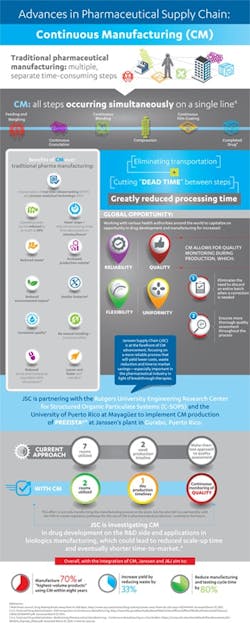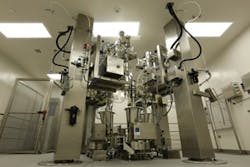Janssen Embraces Continuous Manufacturing for Prezista
Janssen Supply Chain, part of Janssen Pharmaceuticals Inc., announced production of Prezista would transition from batch processing to continuous manufacturing (CM) at its Gurabo, Puerto Rico, plant. According to Janssen Supply Chain’s summer 2015 press announcement, the company “is at the forefront of CM advancement, focusing on a more reliable process that will yield lower costs, waste reduction and time-to-market savings — especially important in the pharmaceutical industry in light of breakthrough therapies.”
Janssen and its corporate parent, Johnson & Johnson, declared they aimed to manufacture 70 percent of “highest volume” products using CM within eight years, increase yield by reducing waste 33 percent, and reduce manufacturing and testing cycle times by 80 percent. Janssen claims the CM methodology it is deploying can reduce operating costs by as much as 50 percent and provide increased production volume while requiring less API and reducing waste. To institute CM processing at the site, Janssen said it collaborated with Rutgers University Engineering Research Center for Structured Organic Particulate Systems (C-SOPS, a leading academic proponent of CM) and the University of Puerto Rico.
For Janssen, the decision to introduce CM into its operations was neither undertaken lightly nor made over night. According to Mauricio Futran, VP of Advanced Technology for Janssen Manufacturing & Technical Operations, the relationship with Rutgers began nearly 10 years ago. Futran says the strategy to go CM has its roots in Janssen’s commitment to enhanced reliability and advanced understanding pharmaceutical processes. It’s also part of the reason Janssen joined the Rutgers’ consortium as one of its first members. “We share this commitment to enhance the technology we use for manufacturing,” says Futran, noting that the CM strategy evolved gradually from that philosophy, and about five years ago the initiative to develop a continuous manufacturing approach rose to become a top priority for the group. “We watched the technology develop and when it really got to where we felt it offered an opportunity to support an appropriate proof of concept, we decided to pursue it and learn how to bring it online.”
To many academics, technocrats and corporate proponents of CM like Pfizer, the economics and efficiencies of the methodology are well established. So why aren’t Pharma’s manufacturers moving to embrace the methodology and develop CM manufacturing facilities in a more wholesale fashion? The simple answer is: it’s complicated. Some argue that no matter how efficient CM drug processing is and how large the operational benefits are, the process is never going to beat the “real politic” of the industry in terms of overall operating economics, which explains that the lifecycle cost benefits of CM will never supersede the operating economics of validated, written-off, large-scale legacy capacity. Scale is another issue some say, and critics complain CM is not cost effective on a smaller or medium scale. Is this the case? “Well, I think the answer really depends,” says Futran. “We have done a fair amount of work and we’re still doing work on understanding the various factors that impact the financial side of the equation.”
Prezista’s ingredients must be staged properly and measured accurately. Weighing operations (shown here) are especially critical for proper formulation. (Photo courtesy of Janssen)
For instance, Futran explains the efficiency part of the equation can be impacted by a plant’s scale because the cleaning effort and similar will remain relatively the same whether it’s a bigger plant or a smaller one. Similarly, the physical attributes the tablet can effect the efficiency “return” of CM methods. According to Futran, his organization is all about “the efficiency,” explaining that the 11 elements of efficiency outlined in the company’s infographic (next page) form the core list of assessment points that will help Janssen understand the economics and financial performance of CM-based oral solid dose processing within the context of the organization’s overall capacity.
BEST FOR SOLID DOSE
Futran says Janssen chose to configure the CM line for the direct compression of Prezista 600 mg tablets because “as you know, it is the simplest way to make a tablet, and we based it on a similar line that Rutgers developed and installed.” Explaining that the compound has reasonable drug loading and is very well characterized, Futran noted, “The back [end] process is very stable, so we thought it was an ideal platform to learn how to do this.”
Approved in 2006, Prezista (darunavir) is a protease inhibitor (PI) and one of the rare, orally administered solid dose-form biologics. Darunavir is an antiviral medication that prevents human immunodeficiency virus (HIV) cells from multiplying in the body. Wikipedia informs us Darunavir is a second-generation PI designed specifically to overcome problems with the older agents in this class, such as indinavir. Early PIs, says the source, often have severe side effects and drug toxicities, require a high therapeutic dose, are expensive to manufacture and show a “disturbing susceptibility to drug-resistant mutations.”
Futran explained that Janssen decided to take the concept to a higher, more commercially acceptible level, engineering the CM line to be versatile and more reliable. To prepare the line for commercial-ready industrial scale production, Futran says the company’s engineers specified more sophisticated controls and enhanced environmental health and safety features.
For example, process analytical technologies (PAT) can play a key role in understanding the process and the elements that work to sustain product quality over the length of a production run. Blend uniformity is one such parameter. “We’re looking at blend uniformity and continuity uniformity and ID,” says Futran, “to make sure they’re all supposed to be [correct] on a real-time basis.” But under DOE rigor, the role of PAT technologies has its limits, and do not necessarily offer a means of controlling line stability or process variability. Good process design comes from many places, including experience: “We’ve learned through a fair amount of work and engineering to run a very stable line,” says Futran, “but we really want to get better; rather than stick to a traditional view [of drug manufacturing] and really never get better.”
When you have a continuous tablet processing in a commercial setting, raw material intake and preparing excipients, API, etc., is an important operational aspect of CM worth getting right — right from the start. Initial CM operations involve mixing and blending the formulation and staging ingredients and raw materials so they are ready and with adequate supply for a proscribed production run. “There’s a room adjacent to the equipment room,” says Futran, “where an operator stages various excipients and API. Pneumatic conveyors transport the materials from there to sieves to remove any large materials or faults before they get to volume entry feeders and biometric feeders.”
Several operations are necessary to get Prezista from mixing and blending to final tablet form. Tablet press and dedusting operations shown here. (Photo courtesy of Janssen)
Janssen piloted the CM concept with Rutgers in their facilities, and then using that experience, translated it to a commercial operation. But Futran explains the journey to commercially ready, prime-time production was not exactly a Sunday walk in the park. “It wasn’t just copy and paste,” says Futran. “There’s been a lot of learning: as you do longer runs, as you validate the PAT and the chemometric models, as you learn how feeders are effected by vibrations [and other aspects of operation] like that.” Futran says there’s always a lot to learn, noting confidently, “So when you learn all those things, you learn how to make a rock stable line.” Ultimately, says Futran, he and his team are aiming for real-time release of the product and closer control in the future.
Like any leap into new manufacturing paradigms, getting the financial powers to allocate the company’s resources to make the jump can be daunting — no matter how great the projected outcomes may be. Senior management can be very skeptical and reluctant to change, especially when it requires significant investment.
How on board was Janssen’s leadership? Futran said the initiative’s acceptance and eventual green light had much to do with Janssen’s prevailing corporate culture. “I think our senior management is very supportive of innovation, and so the first thing they supported was the membership and participation of the engineering and research center at Rutgers.” Futran characterized the attitude of his leadership this way: “I think they strike a great balance of between being very supportive and prudent; prudent and driven. So that’s why we had to see what we considered proof of concept at Rutgers before bringing [it to the organization] and then getting an appropriate concept to be built here.”
Ultimately, touts Janssen’s infographic, the company is looking toward institutionalizing CM methodology throughout its operations, and Futran and his team are ready for it. “We’ve learned how to set up and control a [CM] line,” notes Futran. “We’ve learned a lot about the business case, all the aspects of its financial liability, environmental impact; all those things.”
According to Futran and Janssen, they are assigning priority as to which compounds to develop next for CM processing. “We have an agreement with Rutgers, says Futran, “to begin working with them in partnership [in an effort] to bring a mutual characterization of the products and materials.” Judging from announcements describing their commitment to CM, it’s clear Janssen has embraced CM as its centerpiece strategy and the future of its manufacturing operations. Is CM the future? When asked, Futran confirms it: “Yes, [Janssen] would like a clear majority of solid dosage forms to be made by these technologies.”



